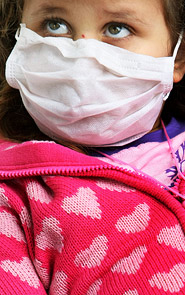See also: Tamiflu drug made with cocktail of chemical ingredients, linked with bizarre behavior (Natural News)
 Children report a range of side-effects, but the official advice is that Tamiflu is safe |
More than half of children taking the swine flu drug Tamiflu experience side-effects such as nausea and nightmares, research suggests.
An estimated 150,000 people with flu symptoms were prescribed the drug through a new hotline and website last week, according to figures revealed yesterday.
Studies of children attending three schools in London and one in the South West showed that 51-53 per cent had one or more side-effects from the medication, which is offered to everyone in England with swine flu symptoms.
The research by the Health Protection Agency emerged as Sir Liam Donaldson, the Chief Medical Officer for England, said that swine flu infections “may have reached a plateau”.
Releasing the latest figures, Sir Liam said that an estimated 110,000 new cases of the H1N1 virus were diagnosed by doctors in the week to Sunday. That did not include those using the new National Pandemic Flu Service for England to obtain antiviral drugs without seeing their GP.
Sir Liam said that the deaths of 27 people in England were confirmed to have been linked to swine flu, compared with 26 last week. As of Wednesday morning 793 people were in hospital in England with the virus, and 81 were in intensive care.
Yesterday Natasha Newman, 16, of Highgate, North London, was seriously ill in hospital in Athens after contracting swine flu while on holiday on the island of Cephalonia. Her parents, Julian Newman and Nikki Boughton, were at her bedside at the Agia Sofia children’s hospital, said a spokeswoman for Mr Newman’s business, J. Newman Textiles. “This is a very distressing and worrying time,” she said.
Peter Holden, the British Medical Association’s lead expert on swine flu, suggested that Tamiflu was being overused and did not need to be offered to everyone with mild symptoms. “The National Pandemic Flu Service has been a great success, and was needed to take the pressure off GPs,” he said. “But the threshold for getting Tamiflu should be quite high.
“For patients who are not in the high-risk groups — such as pregnant women, people with bad asthma or with suppressed immune systems — this virus typically causes mild symptoms and does not require a course of Tamiflu. Patients in the at-risk groups should be referred to their GP, who will use their clinical judgment.”
A total of 103 children took part in the London study, of which 85 were given the drug as a precaution after a classmate received a diagnosis of swine flu. Of those, 45 experienced one or more side-effects. The most common was nausea (29 per cent), followed by stomach pain or cramps (20 per cent) and problems sleeping (12 per cent). Almost one in five had a “neuropsychiatric side-effect”, such as inability to think clearly, nightmares and “behaving strangely”, according to the research, published in Eurosurveillance, a journal of disease.
The study was carried out in April and May when the drug was being issued as a preventive measure. The findings were echoed by a study of children at a school in the South West where a pupil had caught the disease in Mexico.
Health officials in Japan have recommended against prescribing Tamiflu to teenagers over fears it causes a rise in “neuropsychiatric events”. The researchers said that clinical trials had shown that about 20 per cent of adults reported side-effects of either nausea or vomiting after taking Tamiflu.
Both the Department of Health and the Medicines and Healthcare Regulatory products Agency said that the drug was safe, and that the benefits of treating early symptoms and avoiding potentially serious complications could outweigh the risks of side-effects.
Sir Liam said that despite a 10 per cent rise in the estimated number of cases in the week to Sunday, the latest figures reinforced “a growing impression we have had a peak”. He said that a surge would still be expected in the winter flu season, but added: “I think we are a little more confident we may be seeing a downturn in this flu.”
Scale of the outbreak
— 110,000 new swine flu cases in England last week, based on data from GPs
— 150,000 people obtaining Tamiflu without seeing a GP since last Thursday
— 51% to 53% proportion of children reporting side-effects from taking Tamiflu
— 1 in 158 people in England have contacted their GP with flu-like symptoms since outbreaks began. The rate is 1 in 77 for children aged 1 to 4
Source: Department of Health
July 31, 2009
David Rose
Source: The Times